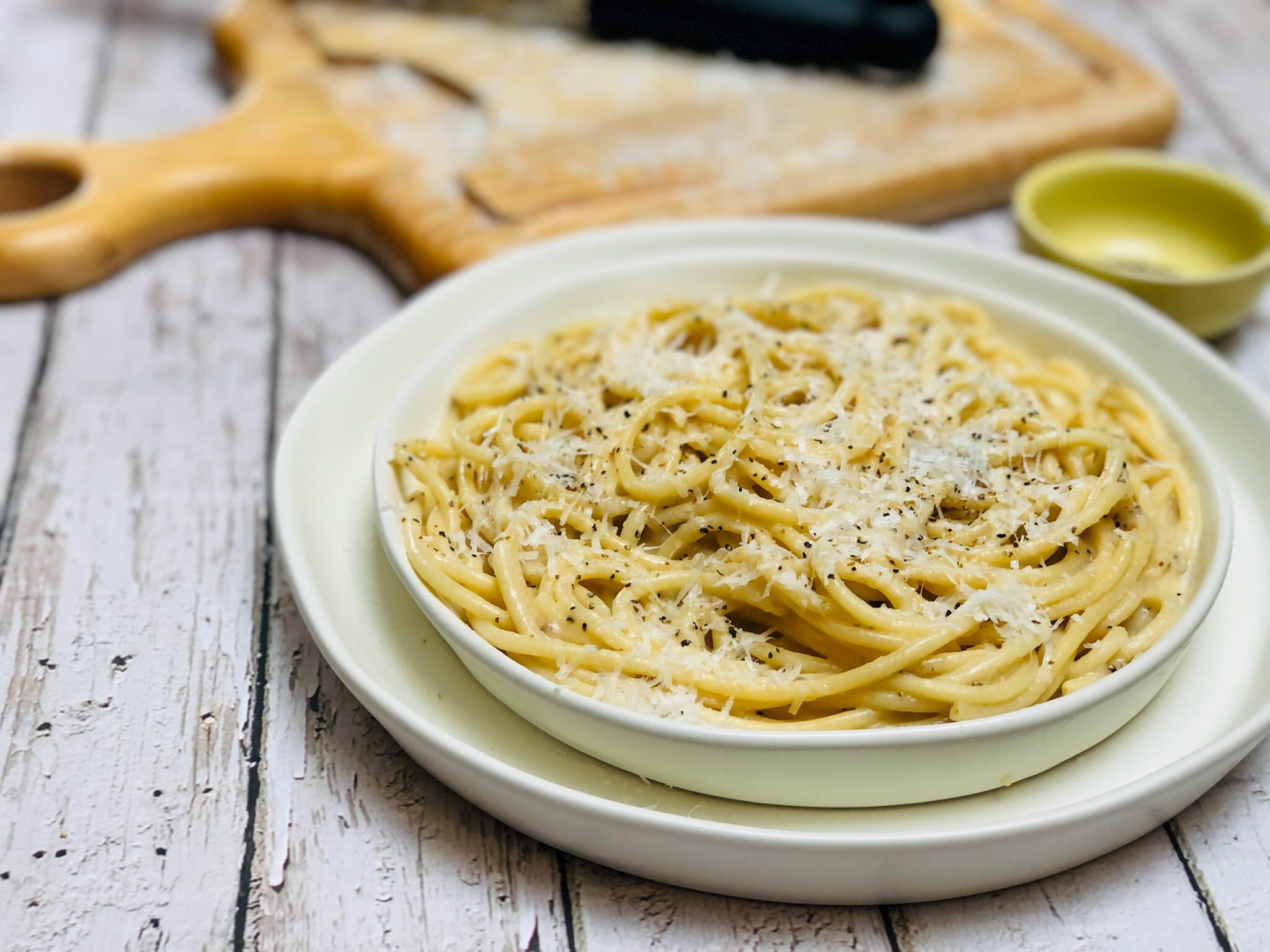Bucatini Cacio e Pepe: Authentic Foolproof Recipe
Cacio e Pepe, pronounced “KAH·chee·oh e PEH·peh,” has recently skyrocketed to fame in the United States. Ironically, it’s one of the oldest recipes in Roman Cuisine and even dates back to the Roman Empire. The three simple ingredients: sheep’s cheese, black pepper, and dried thick pasta were ideal for Roman sheep herders to transport.
Cacio (cheese) e pepe (and black pepper) simply translates to “cheese and black pepper.” However, it is understood that when ordering this famous Roman dish, it would be pasta cacio e pepe, or “cheese and black pepper pasta.” Our traditional recipe for this classic Roman dish uses bucatini pasta, so it’s Bucatini Cacio e Pepe.
The best part: This foolproof Cacio e Pepe recipe is absolutely delicious and only takes about 30 minutes to make from start to finish! It’s one of those easy pasta recipes you’ll make again and again.
Compared to the other 3 classic Roman pastas: Gricia (beef cheeks sauce), Amatriciana, and Carbonara, Cacio e Pepe is the most simplistic, but not necessarily the easiest to master.
But guaranteed, if you visit Rome, you’ll want to make this simple dish when you return. And our Bucatini Cacio e Pepe recipe is the bomb!
Authentic Bucatini Cacio e Pepe Recipe
This is an authentic Bucatini Cacio e Pepe recipe! A lot of recipes—dare I say, most of the recipes I see—are definitely NOT authentic Cacio e Pepe recipes. They may more appropriately be called Italian Mac and Cheese or Italian Cheese Pasta.
The traditional Cacio e Pepe pasta, cheese, and method for making this treasured Roman dish leave little room for reinvention. Although a creamy Cacio e Pepe does take some finesse, and would be easier if there was a Cacio e Pepe sauce, I like to stick to the real deal Roman recipe.
And with these tips, you’ll find it’s not so hard after all. Here’s what you need for an authentic Cacio e Pepe ricetta (recipe).
Traditional Cacio e Pepe Pastas
If you want to know how to make Cacio e Pepe like a Roman, the first step is to use a traditional Cacio e Pepe pasta, which are bucatini, spaghetti, or tonnarelli. In the U.S., tonarelli cacio e pepe will be the most difficult to make as tonarelli pasta is the hardest to find.
Personally, I prefer the thicker long pasta with a whole in the middle over spaghetti, so our authentic Cacio e Pepe recipe uses bucatini pasta. But Spaghetti Cacio e Pepe (especially thick spaghetti) will certainly still be delicious, especially if that’s the type of pasta that’s in your pantry.
Traditional Cacio e Pepe Cheese
Traditional Roman recipes use ingredients from Rome or the surrounding region. So, the traditional cheese to be used for authentic Cacio e Pepe recipes is either Pecorino Romano, Cacio de Roma, or a combination of these two Roman cheeses.
In U.S., the sheep’s milk cheese Pecorino Romano is readily available, so that is our cheese of choice for this Bucatini Cacio e Pepe recipe. It is not only one of the most popular cheeses of Italy, it is the cheese most traditionally used for this dish.
Of course, if you cannot get that, or prefer Parm, it will make a good substitution. However, Parmigiano-Reggiano cheese, Parmesan cheese, or Parm as we sometimes call it, is not a Roman cheese; it comes from Parma in the foodie region of Emilia-Romagna.
No matter what, do not use pre-grated cheese! If you do, you will no longer have a foolproof Cacio e Pepe recipe. Since you’re not making a cheese sauce, it will not melt or combine well. Also, your Cacio e Pepe pasta will most likely end up lumpy.
Pre-Ground Black Pepper or Fresh CrackeD Pepper for Cacio e Pepe?
You can use either pre-ground black pepper or fresh cracked whole peppercorns for cacio e pepe. The key is that the pepper has to be fresh. Usually, cracked pepper is coarser, but you can also purchase coarse black pepper. The coarseness comes down to personal preference. If your ground pepper is fresh and kept in an airtight container, it will be tasty.
Authentic Cacio e Pepe Recipe
Whether you’re making Cacio e Pepe Bucatini, spaghetti, or tonnarelli, the method is the same for this traditional Roman dish. Although it may appear that there’s a creamy sauce, there is no “Cacio e Pepe sauce” per se.
And a Cacio e Pepe ricetta does not include butter (not even unsalted butter), olive oil, or cream! A recipe with any of these ingredients is a dead giveaway that you are not using an authentic Cacio e Pepe recipe.
When making true Roman Cacio e Pepe, the ingredients are combined in a way that makes the pasta creamy-saucy without making a separate sauce or using additional ingredients.
However, with the burst in popularity of Pasta Cacio e Pepe, many restaurants even in Italy are making a separate cheesy sauce to use on everything from pizza to croquettes. But the best Cacio e Pepe Rome has to offer is still the 3-ingredient traditional Cacio e Pepe pasta.
Bucatini Cacio e Pepe Recipe
Servings: 4
Ingredients
2 quarts water
½ teaspoon kosher salt
12 ounces bucatini pasta
7 ounces Pecorino Romano cheese
2½ teaspoons cracked black pepper
Instructions
1. Bring 2 quarts of water and salt to a boil in a large skillet or pasta pot. Do NOT follow package direction for water quantity, only for cooking time.
2. Add bucatini pasta when water comes to a boil. It is important not to add additional water, as you want the water as starchy as possible. You can use a deep skillet, or use tongs if needed to bend the bucatini with a little twist to get it under the water as soon as possible. Use the tongs to stir the pasta intermittently.
3. The key to successful and creamy Bucatini Cacio e Pepe: Grate the Pecorino as fine as you can by hand. The best way is to use a microplane; that is the preferred method. If you don’t have a microplane, use the smallest hole available on your grater.
Since there is not a Cacio e Pepe sauce, the grated Pecorino Romano cheese needs to be very fine in order to melt properly. For best results, do not use pre-grated Pecorino Romano cheese and do not grate the cheese more than a half hour ahead of cooking your pasta.
4. Reserve ½ cup of the Pecorino Romano and ½ teaspoon of cracked black pepper, and set each aside.
5. In a bowl, add the remaining black pepper to the remaining grated cheese, lightly mix, and set aside.
6. When the bucatini pasta is al dente, drain the pasta water into a large glass measuring cup, or bowl, and set aside. Keep the cooked pasta in the pot on the burner over medium heat. You need hot pasta to melt the cheese. Don’t worry about the pasta being too wet.
7. Add 1 cup of the reserved pasta water back to the bucatini, and sprinkle in half of the cheese and pepper mixture. Stir well and quickly with kitchen tongs so that the cheese becomes creamy. Then add the remaining cheese and pepper and an additional ½ cup of pasta water so the cheese melts. Set the remaining pasta water aside.
8. If your pepper and cheese “sauce” begins to get lumpy, turn the heat on the lowest possible setting for a minute, keep stirring, and things should smooth out. Or, you can add a little bit more water a couple of tablespoons at a time. Or, if needed, do both.
9. Heat a shallow serving bowl or dish in the microwave for a couple of minutes or run it under hot water and dry it.
10. Transfer the pasta to the serving bowl, add the separately set-aside, unmixed cheese and pepper as garnish, and serve immediately. I make sure everyone is at the dinner table before I make the transfer to the bowl.
What to serve with Cacio e Pepe Pasta?
Want to know what to serve with this classic Italian pasta dish? Whether it’s Tonarelli, Bucatini, or Spaghetti Cacio e Pepe, it’s still a Roman pasta dish, and the flavors pair especially well with many foods in Italian cuisine as well as French cuisine, and even those of Mediterranean cuisine.
Bucatini Cacio e Pepe Side Dish
Since this Pecorino cheese and black pepper pasta can be pretty rich, it’s a good complement to plainer proteins like roasted chicken or grilled fish or steak. If you want something a little more impressive, try it next to chicken or Fish Francaise. I love it next to Mediterranean Lamb Chops.
Bucatini Cacio e Pepe Entrée
I think this is one of the best pasta dishes! I can eat a plate of pasta with pepper and cheese any night of the week and be happy to call it dinner.
However, I also love my veggies, so a side vegetable of roasted brussels sprouts or broccoli would be my top 2 choices. Sometimes I serve Bucatini Cacio e Pepe with a simple salad, like this cucumber, tomato, and onion, or, when in season, this Strawberry Arugula Salad.
Paste Cacio e Pepe in Rome
Every foodie visiting Rome should try this dish!
When ordering Bucatini Cacio e Pepe in Rome, it is most likely going to be a primo piatto, a pasta course eaten before the main course. But if you’re a real pasta lover like me, don’t be afraid to order a pasta dish for your secondo (second course) too! Yes, I have done this many times, and no one ever minded!
Anthony Bourdain filmed an episode of No Reservations where he ate and loved this traditional pasta. When it first aired, they kept the restaurant in Rome a secret. Bourdain later revealed it to be Ristorante Roma Sparita. The ancient shepherds had no idea their peasant food would become such a sensation!
Nowadays, you can even find Cacio e Pepe to-go as a street food in Rome.
Do you love authentic Cacio e Pepe?
I’d love to hear where you’ve had it? How was it served? Have you made homemade Cacio e Pepe? Will you try this Bucatini Cacio e Pepe recipe? Let us know in the comments!
Looking for more easy recipes? How about one for another classic Italian dish?
Make this homemade marinara sauce recipe and never buy a jar of marinara sauce again! Or try my favorite recipe for fresh tomatoes, pasta pomodoro!
Our Most Popular Italian Recipes
Pasta di Frittata
Authentic Italian Marinara
Bolognese Sauce
Genovese Pesto Sauce
Lemon-Garlic Risotto with Prawns
Sloppy Giuseppe
Skinny Shrimp Scampi










